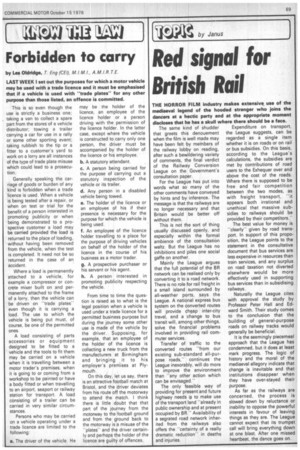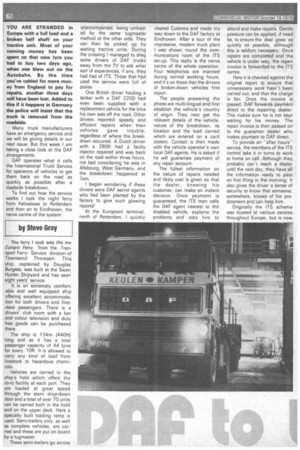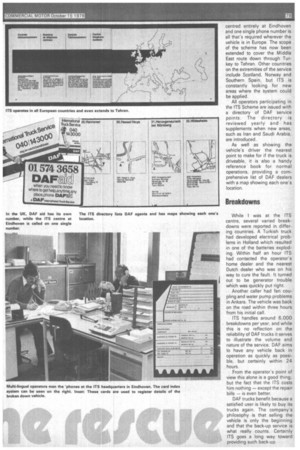Red signal for British Rail
Page 69

Page 78

Page 79

If you've noticed an error in this article please click here to report it so we can fix it.
THE HORROR FILM industry makes extensive use of the mediaeval legend of the hooded stranger who joins the dancers at a hectic party and at the appropriate moment discloses that he has a skull where there should be a face.
The same kind of shudder that greets this denouement when the film is well made may have been felt by members of the railway lobby on reading, after such a bewildering variety of comments, the final verdict of the Railway Conversion League on the Government's consultation paper.
For the League has put into words what so many of the other comments have conveyed by hints and by inference. The message is that the railways are no longer necessary and that Britain would be better off without them.
This is not the sort of thing usually discussed openly, and especially within the formal ambience of the consultation waltz. But the League has no inhibitions and piles one social gaffe on another.
Mainly the League argues that the full potential of the BR network can be realised only by converting it to a road network. There is no role for rail freight in a small island surrounded by all-weather ports, says the League. A national express bus system on the converted routes will provide cheep inter-city travel, and a change to bus transit will, among other things, solve the financial problems involved in providing rail commuter services.
Transfer of traffic to the converted routes -from our existing sub-standard all-purpose roads," continues the League inexorably, will do more to improve the environment than "any other action which can be envisaged."' The only feasible way of providing for present and future highway needs is to make use of the transport land "already in public ownership and at present occupied by BR." Availability of a segrated road network inherited from the railways also offers the "certainty of a really dramatic reduction" in deaths and injuries. Expenditure on transport, the League suggests, can be regarded as a single item whether it is on roads or on rail or bus subsidies. On this basis, according to the League's calculations, the subsidies are met by contributions of road users to the Exhequer over and above the cost of the roads. Where there is supposed to be free and fair competition between the two modes, as with freight transport, "it appears both irrational and unethical that massive subsidies to railways should be provided by their competitors.
The best value for money is "clearly" given by road transport. In support of this proposition, the League points to the statement in the consultative document that bus services are less expensive in resources than train services, and any surplus on road taxation not diverted elsewhere would be more effectively used in supporting bus services than in subsidising railways.
Naturally the League cites with approval the study by Professor Peter Hall and Edward Smith. Their study comes to the conclusion that the building of general-purpose roads on railway tracks would generally be beneficial.
It is the seemingly piecemeal approach that the League has condemned, but it does at least mark progress. The logic of history and the moral of the mediaeval allegory indicate that change is inevitable and that institutions disappear when they have over-stayed their purpose.
As far as the railways are concerned, the process is slowed down by reluctance or inability to oppose the powerful interests in favour of leaving things as they are. The League cannot expect that its trumpet call will bring everything down at one blast After one missed heartbeat, the dance goes on. YOU ARE STRANDED in Europe with a full load and a broken half shafi on your tractive unit. Most of your running money has been spent on that new tyre you had to buy two days ago, when one blew out on the Autobahn. By the time you've cabled for more money from England to pay for repairs, another three days will have been lost. Added to this if it happens in Germany the police will insist that the truck is removed from the roadside.
Many truck manufacturers have an emergency service and we will be giving details in our next issue. But this week I am taking a close look at the DAF arrangements.
DAF operates what it calls the International Truck Service for operators of vehicles to get them back on the road as quickly as possible after a roadside breakdown.
To find out how the service works I took the night ferry from Felixstowe to Rotterdam and then on to Eindhoven, the nerve centre of the system. unaccompanied, being unloaded by the same tugmaster method at the other side. They can then be picked up by waiting tractive units. During the crossing I managed to drag some drivers of DAF trucks away from the TV to ask what sort of experiences, if any, they had had of ITS. Those that had used the service were full of praise.
One British driver hauling a tanker with a DAF 2200 had even been supplied with a replacement vehicle for the time his own was off the road. Other drivers reported speedy and efficient repairs when their vehicles gave trouble, regardless of where the breakdown occurred. A Dutch driver with a 2800 had a faulty injector repaired and was back on the road within three hours, not bad considering he was in Allsbourg, West Germany, and the breakdown happened at 7am.
I began wondering if these drivers were DAF secret agents who had been planted by the factory to give such glowing reports!
At the Europoort terminal, north of Rotterdam, I quickly cleared Customs and made my way down to the DAF factory at Eindhoven. After a tour of the impressive, modern truck plant I was shown round the communications room of the ITS set-up, This really is the nerve centre of the whole operation. Four telephones are manned during normal working hours, and it's on these that the drivers of broken-down vehicles first report.
The people answering the phone are multi-lingual and first establish the vehicle's country of origin. They next get the relevant details of the vehicle, nature of the breakdown, its location and the load carried which are entered on a card system. Contact is then made with the vehicle operator's own local DAF agents. He is asked if he will guarantee payment of any repair account.
The fullest information on the nature of repairs needed and likely cost is given so that the dealer, knowing his customer, can make an instant decision. Once payment is guaranteed, the ITS man calls the DAF agent nearest to the disabled vehicle, explains the problems and asks him to attend and make repairs. Gentle pressure can be applied, if need be, to ensure the deal goes as quickly as possible, although this is seldom necessary. Once repairs are completed and the vehicle is under way, the repair invoice is forwarded to the ITS centre.
Here it is checked against the original report to ensure that unnecessary work hasn't been carried out, and that the charge is fair. Once the invoice is passed, DAF forwards payment direct to the repairing dealer. This makes sure he is not kept waiting for his money. The repair invoice is then passed on to the guarantor dealer who makes payment to DAF direct.
To provide an "after hours" service, the members of the ITS control take it in turns to work at home on call. Although they probably can't reach a dealer until the next day, they have all the information ready to pass on first thing in the morning. It also gives the driver a sense of security to know that someone, somewhere, knows of his predicament and can help him.
Originally the ITS scheme was located at various centres throughout Europe, but is now centred entirely at Eindhoven and one single phone number is all that's required wherever the vehicle is in Europe. The scope of the scheme has now been extended to cover the Middle East route down through Turkey to Tehran. Other countries on the extremities of the service include Scotland, Norway and Southern Spain, but ITS is constantly looking for new areas where the system could be applied.
All operators participating in the ITS Scheme are issued with a directory of DAF service points. The directory is reviewed yearly and has supplements when new areas, such as Iran and Saudi Arabia, are introduced.
As well as showing the vehicle's driver the nearest point to make for if the truck is driveable, it is also a handy reference book for normal operations, providing a comprehensive list of DAF dealers with a map showing each one's location.
Breakdowns
While I was at the ITS centre, several varied breakdowns were reported in differing countries. A Turkish truck had developed electrical problems in Holland which resulted in one of the batteries exploding. Within half an hour ITS had contacted the operator's home dealer and the nearest Dutch dealer who was on his way to cure the fault. It turned out to be generator trouble which was quickly put right.
Another caller had fan coupling and water pump problems in Ankara. The vehicle was back on the road within three hours from his initial call.
ITS handles around 6,000 breakdowns per year, and while this is no reflection on the reliability of DAF trucks it serves to illustrate the volume and nature of the service. DAF aims to have any vehicle back in operation as quickly as possible, but certainly within 24 hours.
From the operator's point of view this alone is a good thing, but the fact that the ITS costs him nothing except the repair bills -is even better.
DAF trucks benefit because a satisfied user is likely to buy its trucks again. The company's philosophy is that selling the vehicle is only the beginning and that the back-up service is what really counts. Certainly ITS goes a long way toward providing such back-up.






















































































































